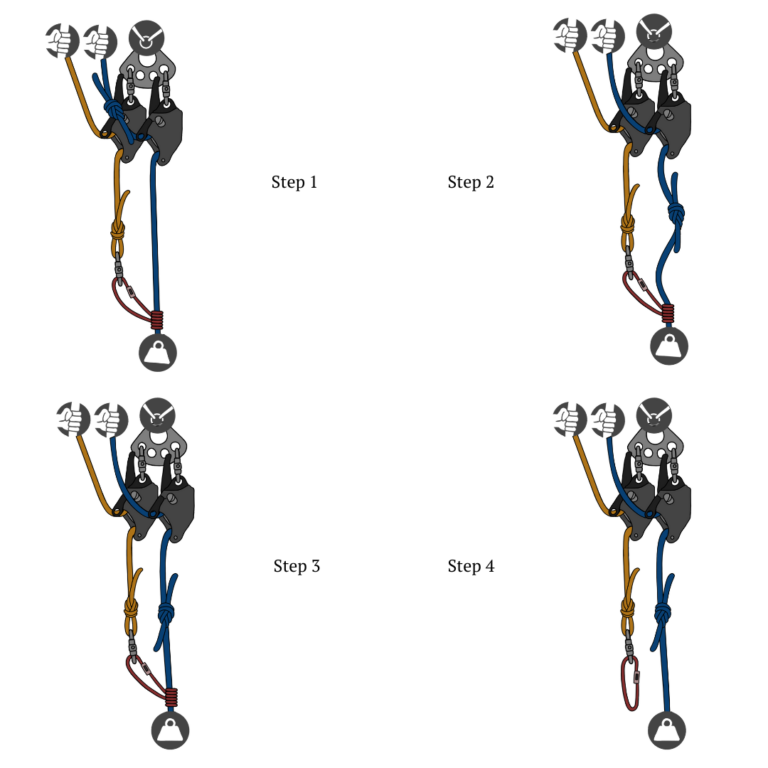Mastering the Lowering Piggyback Method: A Narrative Approach
In the demanding world of technical rope rescue, precision, and adaptability are key to ensuring the safety of both rescuers and those in need. Among the many techniques honed for managing complex rope systems, the Lowering Piggyback Method stands out as an innovative and reliable approach. Designed to handle knots and maintain seamless control during descents, this method integrates a secondary descent control system to achieve unparalleled safety and efficiency.
Why the Lowering Piggyback Method Matters
Picture a rescue scenario unfolding on a steep mountainside. The main rope system is under tension, a critical knot approaching the descent control device. Here, the stakes are high: maintaining load stability while navigating the knot without interruption is essential. This is where the Lowering Piggyback Method comes into play. By employing a secondary descent system, this method ensures that the transition is smooth, the load is secure, and operations remain uninterrupted.
The Method in Action
The process begins with meticulous preparation. As the knot nears the primary descent device—be it a Clutch, MPD, or Maestro—the load must be carefully positioned. At this stage, the operator activates the device’s locking mechanism, halting the descent momentarily. Enter the piggyback system, a secondary control mechanism anchored securely and connected to the main line with a Prusik hitch. This system is not just a backup; it becomes the centerpiece for managing the knot.
With the piggyback system in place, the load transitions effortlessly from the main line to the secondary system. This moment of transfer is critical, requiring precision and focus. As the knot passes the primary descent device, it is repositioned, clearing the path for a continuation of the descent. The operator then re-engages the primary device, transferring the load back smoothly to the main line, ensuring stability and control throughout.
The Advantages of Mastery
The brilliance of the Lowering Piggyback Method lies in its efficiency and adaptability. By leveraging a secondary system, rescuers gain greater control over the load during critical phases of the operation. This control minimizes risks associated with sudden jerks or slips, providing a buffer that enhances safety for all involved. Moreover, the method’s flexibility allows it to be employed across various devices, making it a universal tool in the rescuer’s arsenal.
Beyond Technique: The Bigger Picture
Mastering the Lowering Piggyback Method is more than learning a series of steps—it’s about adopting a mindset of precision and preparation. Rescue scenarios are unpredictable, but with methods like this, teams can approach challenges with confidence. The ability to manage knots seamlessly, maintain load stability, and adapt to different devices ensures that operations run smoothly even in the most challenging environments.
The Path to Proficiency
Rescue teams aiming to integrate this technique into their repertoire must invest in hands-on training and scenario-based drills. Regular practice with the piggyback system fosters familiarity with its components and instills confidence in its application. Furthermore, routine inspections of ropes, hitches, and devices are essential to ensure optimal performance and safety.
Conclusion: Elevating Rescue Operations
The Lowering Piggyback Method represents the intersection of innovation and reliability in technical rope rescue. By mastering this approach, teams can elevate their operations, ensuring not just successful outcomes but also enhanced safety and efficiency. It’s a testament to the power of strategic thinking and the relentless pursuit of excellence in one of the most demanding fields.
In every knot passed and every load secured, the essence of the Lowering Piggyback Method is clear: precision, control, and an unwavering commitment to safety. As rescuers continue to push the boundaries of what’s possible, techniques like this remain at the forefront, enabling them to face the most formidable challenges with confidence and skill.
Resource Links
(Rigging Lab Academy Resources):
- Rigging Lab Academy Courses
- Link to the training catalog where readers can learn more about rope rescue techniques.
- Advanced Rope Rescue Systems
- Specific content on rope rescue systems for those wanting to dive deeper.
- Knot Management in Rope Rescue
- Educational materials focused on managing knots during operations.









